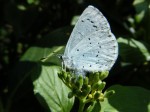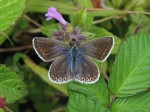Currently recorded on campus are two species of blue coloured butterflies these ar: the Holly Blue (Celastrina argiolus) and the Common Blue (Polyommatus icarus). To the untrained eye, in flight, they look the same, and telling the difference between the species is therefore difficult. The two species are within the Lycaenidae family, know as the blue butterflies which also includes the Small Copper (Lycaena phlaeas), Purple Hairstreak (Favonius quercus) and Brown Argus (Aricia agestis) which are not blue and are found on campus too.
The species are superficially similar and their flight periods do overlap, but there are some major differences:
- The undersides of the wings have totally different patterns. For Holly Blue, it is rows of black dots against a chalky light blue background, see image 1. For Common Blue, the black dots are surrounded by a white circle, and there are orange dots that run down the back edge of each wing, against a blue grey to light brown background see image 2.
- From above the males of both species do look very similar i.e. a vivid blue however, the male Holly Blue has a thicker black trailing edge on the forewing, over that of the Common Blue, see image 3 and 4.
- The females of each species are much easier to distinguish. From above, the female Holly Blue has a thick black band that covers ¼ of the forewing from the trailing edge, against the blue background. Whereas, a female Common Blue can be almost brown from above or a mix of brown and blue, but there are always orange and black dots, that run near the edges of the wings, see image 5 and 6.
- From previous experience with this species, the flight height does differ substantially. Holly Blues are often seeing flying high, 4-5 metres above the ground, only coming down to food plants or nectar to land. Whereas, the Common Blue flies low above the grass.
- The species’ wingspans, unfortunately for identification purposes are similar sizes, up to 35mm.
- Image 1 Holly Blue showing distinctive underwing © Justin Groves The University of Reading
- Image 2 Common Blue showing the under side of the wings © Justin Groves The University of Reading
- Image 3 Common Blue male upperside of the wings © UK Butterflies Peter Eeles
- Image 4 Holly Blue male showing upperside of wings © UK Butterflies Peter Eeles
- Image Holly Blue female showing upperside of wings © UK Butterflies Vince Massimo
- Image 6 Common Blue female showing upperside of the wings © UK Butterflies Vince Massimo
- Image 7 Holly Blue caterpillar feeding on Ivy (hedra helix) buds © UK Butterflies Peter Eeles
The distribution of the Holly Blue extends to approximately Carlisle, with scattered records in southern Scotland (provided by the National Biodiversity Network (NBN) UK). The Common Blue is found throughout the UK, including the Shetlands. The NBN Gateway does not currently hold records for either species for Whiteknights campus at 1km resolution.
To distinguish the habitat of the two species; Holly Blue is associated with woodland edge habitats, woodland rides, hedgerows and churchyards. Whereas the Common Blue prefers grassy habitats, waste ground-dune systems, but is often seen in most habitats, except dense woodland. Both species have two flight periods a year, in the case of the Holly Blue this is a spring then summer generation, peaking first in early May, then early August. The larva produced from the summer generation survives the winter as pupae. The Common Blue has an early summer, then mid summer generation, peaking in early June then mid August. The larvae produced from the late summer generation survive the winter as larvae, changing colour from green to olive. The food plants of the Holly Blue differ between generations, the caterpillars produced from the May peak feed predominantly on Holly (Ilex aquifolium) but also Dogwood (Cornus sanguinea) whereas, the caterpillars produced by the August generation, feed on Ivy (Hedera helix). Eggs are usually laid close to unopened flower buds, and I have observed that the caterpillar eats these first, see image 7. Both generations of Common Blue, predominantly feed on Common Birds Foot Trefoil (Lotus corniculatus), but also includes other fabaceae (Pea family) species, where the eggs are laid quite conspicuously on the plants. The Holly Blue caterpillar has 4 instars and 3 moults, whereas, the Common Blue has 5 instars and 4 moults.
Such sites you may wish to visit are:
http://www.butterfly-conservation.org/
http://www.ukbutterflies.co.uk/index.php
http://www.hantsmoths.org.uk/index.htm
We thank photographers from UK Butterflies for permission to use their images. Individual credits are given with each image.
Please record any sighting on campus including the date, in the comments section below, for assessment by subsequent authors.







